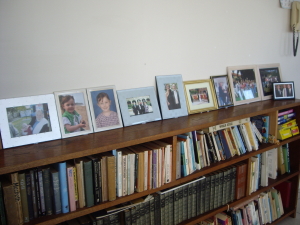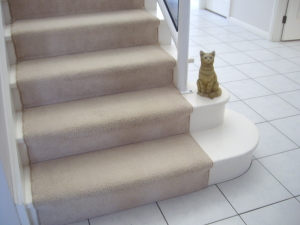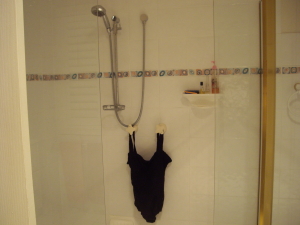Blog 27: Living or Non-living
I sometimes wonder what might have happened if those reflections hadn’t forced us downstairs to sleep. Might I have accosted those two young men at the doorway of one of the upstairs bedrooms? Would they have made a dash for it, knocking me over in the process? Would Bill have had to go into care while I recuperated? Though, in my imagination, I still sometimes see them there at the top of the stairs, black-garbed and white-faced, I am always thankful that things turned out the way that they did and that those reflections, pests that they were, had caused us to obtain the best possible outcome for the situation.
Before I finish talking about reflections and the effects that they had on Bill’s life and mine, I want to tell you about a related loss that Bill suffered. That loss was the loss of the ability to distinguish between the living and the non-living. One of the scientific concepts that we endeavour to teach young children in school is the concept of Living and Non-living. As we do this, we ask the children to glue pictures into two columns, the one containing the pictures of living things, the other, pictures of those that are non-living. The pictures of the pets and the people and the insects and the plants that are all bouncing around and growing and obviously full of life, go into the column titled LIVING. The things that never had life like the coffee mug, the car, the swing set in the backyard and the clock on the wall, all go into the column called NON-LIVING. But the concept becomes tricky for young children when they are confronted with pictures of dead animals, dead birds, dead insects, etc. Contrary to all our urges, these all have to go into the column titled LIVING, because they all once had life. So, let me ask you, where would you glue the picture of the wooden chair? The whole concept, as you can see, is more difficult to comprehend than you would think.
I first came to understand that Bill was having trouble with this when he started to gather up all the framed photos that were placed strategically, on various tables and ledges, around our house. One of those spots, for example was on our family-room bookcase. It looked like this:
One morning, when I got up a little after Bill had risen, I found that he had gathered up all the photo frames that were on that bookcase and was carrying them, awkwardly, in a bundle, wherever he went. Sometimes, he would rest and put them down on the family room table. It wouldn’t be long, though, before he would gather them all up again and take off for a repeat performance. It could go on, on and off, all day.
At first, at night, after Bill had gone to sleep, I would retrieve the photos and put them back, battered and bent, on to the bookcase. But, the next day, Bill would gather them up again and take them on their bundled journey, around and around the inside of the house. Frames became rickety, glass was broken, the tabletop was scratched to death and, one afternoon, while I napped on the lounge, all the legs, at the backs of the frames, were wrenched off. Bill was very pleased with that last achievement. The frames stacked much more easily for him and there were, as a result, fewer mishaps.
This business of carrying the photo frames around and around went on for weeks until, at last, Bill stashed them in the boot of the car and they were allowed to stay there to rest in peace.
The German philosopher, Friedrich Nietzsche (1844-1900), once wisely proclaimed: “there is always some reason in madness.” I looked for the reason behind Bill’s behaviour. The books and the Internet told me that dementia sufferers carry photos around with them in an effort to hold on to fast-fading, precious memories. But this did not ring true to me. Bill was not studying the photos. He did not seem to be trying to memorise the images. He seemed, rather to be trying to get rid of them. I came to the conclusion, as I pondered, that Bill thought that those faces were alive. Even though their demeanours were pleasant, I think that their intense gazes, staring out at him, unnerved him and that, in certain instances, he was no longer able to tell the living from the non-living.
This belief that Bill was beginning to fail to distinguish between those two, was corroborated for me, some time later, when Bill sat on our second bottom stair, adjusting the strap of his sandal. Out of the corner of his eye, he spotted the cat ornament that had always sat there.
“Is it alive?” he asked, a hint of apprehension on his face.
“No!” I answered, picking up the cat. “It’s just an ornament. I think it is made of poly resin.”
“Oh!” he nodded, as if to say: I knew that. I was just making sure.
Another time, he pointed to my swimmers, hanging on the taps in the shower recess.
“Is she still here?” he asked.
“No!” I answered. “She’s gone.” And I quickly put the swimmers into the cupboard.
The loss of discernment that we are talking about wasn’t so bad that Bill couldn’t tell that we human beings, all around him, were alive. He looked at us and interacted with us as if we were real people and when, one day, our ten-month-old granddaughter, Lucy, started to cry, he exclaimed, with genuine concern:
“Oh, no! It’s all right! It’s all right!”
On another occasion, when Lucy was crawling, at a gallop, across the lounge room floor to the dining room table, he cried out in mild panic:
“Look out! Look out! He’s coming! He’s coming!”
Bill could understand most of the LIVING and NON-LIVING concept. When, however, the line between the two became blurred, as it did with photos and life-like ornaments and hanging clothes, he could not cope and, understandably, “glued the pictures in the wrong column.”




Dave
Were they all photos of people or was it the easy access and position of the photos that made Bill move them?
Fay
Now, you’ve made me think, Dave, but yes, they were all of people …. and it had nothing to do with easy access because, later on in the “bundling up photos phase”, all those photos from upstairs …. the graduation photos, lifted from the wall, and your wedding photo …… disappeared. It took me ages to find them. They were not in the usual hiding places but were hidden, very carefully, under the little table upstairs that is covered with the green, full-length table cloth. He was deliberately targetting people. Scenes and flowers all stayed on the walls.
Harold and Nola
Yep! We think you’ve gotten all that right, Fay, what else to say? Nothing more we don’t think. Love, Nola and Hal.
Fay
You can see, reading this Blog, how Bill’s mind had just slipped. He was not crazy. He was not mad. His mind had just slipped a bit so that he was not quite in our reality. If only we could have got in there and pushed his mind back into place.
Fay
I need to make a comment that Hazel Hawke died today, 23/05/2013. She died from Alzheimers disease, the greatest cause of death from dementia in Australia. Hazel had suffered from the disease for over a decade and her daughter, Sue Pieters-Hawke has written that story in the book: “Hazel’s Journey”.
It is reported that Hazel died peacefully “after finally succumbing to complications of dementia.” (Courier-Mail, 24/05/13). What a sad way to go. She was such a kind and beautiful and lovely lady.